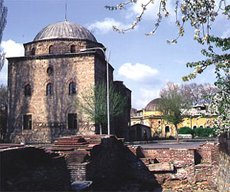|
|
| |
BULGARIA
KYUSTENDIL
Kyustendil is situated in the southern part of the Kyustendil Valley, 90 km south-west of Sofia.
Kyustendil is a national balneological resort at an altitude of 500 m. The town has a population of 54 000. The ancient name of the town Pautalia (a town of springs) is Thracian. The fortress was built by the Romans. Therms, basilicas, floor mosaics have been uncovered. In the 11th C. the town, known as Velbuzhd, after the name of its heir, Konstantin Velbuzhd, became a major religious and administrative centre. About 1355 Velbuzhd and its region were included in the semi-independent feudal Velbuzhd principality of Despot Deyan.
In the 15th C. the town was called Kyustendil, which means a land of Konstantin. In 1372 the Turks conquered the town. During the Bulgarian National Revival crafts and trade flourished.
There are more than 40 mineral springs in the town. The waters are of considerable content of sulphide compounds. These are used for treatment of the locomotory system, gynaecological and other kinds of diseases. The resort region includes several baths, balneological complexes and others.
 There are preserved historical monuments: St. George Church (approx. 11th-12th centuries), a medieval defence tower, named Pirkova Tower (14th C.), Fetih Sultan Mehmed (1531) and Ahmed Bei (1575) mosques, the Holly Virgin Church (1816) and St. Demetrius Church (1866), houses of the Bulgarian National Revival. On Hisarluka Hill there are remains of a fortress dating back to the 4th C., renovated under Justinian (6th C.).
Kyustendil has a historical museum and an art gallery with a rich collection of paintings by the great Bulgarian artist Vladimir Dimitrov Maistora.
|
|
|
Festivals and Fairs
The Great Koprivshtitza Folklore Festival
The Great Koprivshtitza Folklore Festival is Bulgaria's largest gathering of traditional musicians and singers and is a cross between a pop festival and a medieval fair. It is a sight that knows no equal: thousands of musicians and singers making the hillside above the picturesque village of Koprivshtitza their home for a few days. Coupled with this you have the colourful stalls of the traders and the thousands of visitors who come for the festival.
This is Bulgarian music as it was always played, played by the ancestors of those who first played it. But perhaps it is what happens on the periphery that is the most authentic. Strolling players or soloists, simply playing for the sheer enjoyment. forming new bonds with other musicians or just letting their music ring out over the hillside.
The Bourgas International Folk Festival
The Bourgas International Folk Festival, held annually, attracts a host of Bulgarian and international artists and is held in the second half of August.
The Kazanluk Festival
The Kazanluk Festival of the Roses is held annually in early June, and has grown from a local to an international event. Not only are the roses, Kazanluk's main industry, in full flower. but the town itself blossoms while visitors enjoy the "Rose Picnic" and all the fun of a folklore festival, with its costumes, songs and dance. Should you still have the energy left, you can always visit the old factories where the rose oil is extracted.
St. Trifon's Day
In the agricultural calendar, St. Trifon's Day celebrates the pruning of the vines, and is held on February 14.
Kukerov Den
On the first Sunday before Lent, Kukerov Den celebrates the start of the agricultural year, and all over Bulgaria you can witness processions led by the dancing. leaping Kukeri dressed in colourful masks and costumes.
Baba Marta
Baba Marta is celebrated on March 1 when peasant house-holds brush out the winter cobwebs with a traditional spring clean. and people offer each other tokens of good luck called martenitsas.
Kukeri
Like western countries. the Bulgarian calendar is dotted with important feast days and festivals. The festival of the Kukeri re-enacts ancient surovaki rites to ward off evil spirits and Kukeri fertility rites. Although only held once every five years, it brings together dancers from all over Bulgaria in a rainbow of colours and styles.
St. Lazarus Day
Lazaruvane is also celebrated in spring on St. Lazarus Day, and here village girls considered fit for marriage perform ritual songs and dances.
St. Konstantin and St. Elena Day
The coming of summer is traditionally celebrated on St. Konstantin and St. Elena Day on May 21, and in some of the remoter villages in the Stranzha hills fire dancing, dancing on heated coals, is still practised in celebration of summer's arrival. Ethnologists have suggested that this practice is directly descended from Dionysina rites of the ancient Thracian.
|